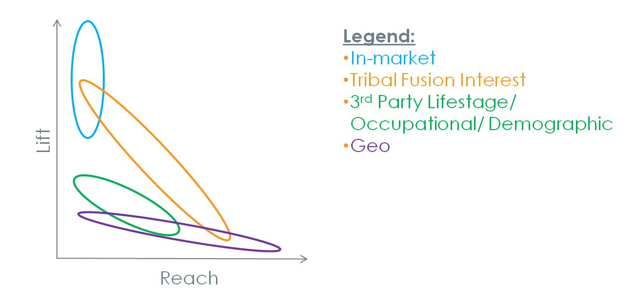
OPS Market’s Focus On Session leader Doug Conely takes us through the concept of ‘audience efficiency’ in his latest blog post. Read Tribal Fusion’s Senior Director for Data & Targeting ‘s piece here.
If you’ve heard me speak, internally and externally, over the last few months you will have heard me refer repeatedly to the concept of “audience efficiency.” I’ve been asked enough times now to explain it again after meetings to explain it in writing… So, what is audience efficiency and why should you care about it?
Lift vs. Reach
Before I can delve into audience efficiency itself I need to explain how we evaluate individual audience segments relative to an advertiser’s target audience, e.g. their product category page visitors or their converters. For this we talk about “lift” versus “reach.” The “lift” is simply the propensity for that audience segment to convert relative to the network average.
For example, if we see a disproportionately high number of users with “luxury in-market” in their profile within the conversion set of a luxury car brand, then we know that segment has high lift. The “reach” is just the size of the audience.
We can visualize this with a lift-reach scatter plot of audiences. See below for a typical target audience result. We talked about this more than a year ago here but it is worth recapping.
The ideal audience would be in the top right quadrant; i.e. it has both very high lift and very high reach. Sadly for our clients, that never happens. What we typically see is a number of behaviours with very high lift but very low reach. These tend to be the in-market and interest-based audiences endemic to the advertiser, similar to my luxury auto example above.
From an insights perspective these audiences tend to validate a marketer’s assumptions about its customers. Then we see a cluster of other interest and branded third-party audiences with moderate lift and low reach that tend to contain some “relevant surprises” in how to describe the advertiser’s target audience. Finally, there are a number of audiences with increasing reach and decreasing lift from higher level interests, e.g. music or travel rather than more granular music artists or destinations.
Overall, we can use this visualization to infer client audience segmentation characteristics for insights purposes and that’s exactly what our Insights Managers do every day.
Audience Efficiency
So can you just add together audiences you like best from the above until you get to some notional reach or lift that you require for your plan? Well, sort of (and I’ll come back to this another time), but we take this a step further and ask ourselves, “What is the set of segments that describe your target audiences with maximum lift for any given reach?”
To do this we take the segment with the highest lift as our starting point and look for the next best segment, but this time with all the users from the first segment removed since we’ve already identified them. As you repeat this process you create a curve of cumulative lift and reach that answers our question above.
This is what I mean by audience efficiency. In a hat tip to stock portfolio theory, we sometimes call the resulting curve the “efficient frontier.” It is mathematically the best you can do in that all points on the curve are equally efficient but with a different lift-reach trade off. Put another way, there is no possible selection of audiences that provides the same lift for a given reach or vice versa.
Audience efficiency can be visualised as a trade off between lift and reach: the higher the lift, the lower the reach and vice versa. One of the benefits of this approach is that one can easily acknowledge and expose that trade off. Another benefit is that it is exactly the same data and science that can power look-alike models. For clients that are buying audience targeted campaigns today, this approach means they can now get more reach for any given lift (or vice versa) and that can only be a good thing.
 |
Doug Conely will be speaking further on Audeience Efficiency at OPS Markets, which will bring digital advertising leaders and ops professionals together to discuss and develop best practices for operational excellence in the evolving automated landscape. Register today for OPS Markets, which will be held February 9, 2012, in London. |